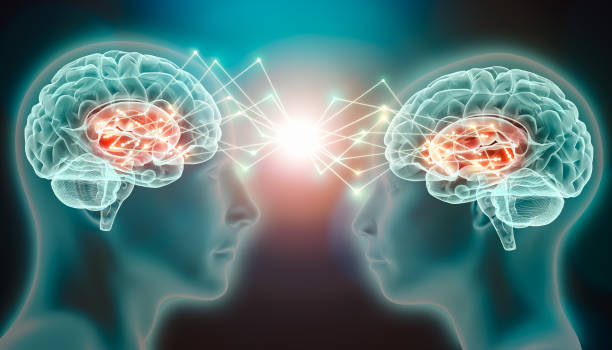It begins quietly. A glance across the room. A laugh shared too long. A brush of hands that lingers a second too late. The moment is ordinary—yet something seismic stirs inside you. Your heart pounds. Your stomach flips. You’re smiling for no reason. Your thoughts begin to orbit one person, drawn like a satellite around a sun.
This is love—or the beginning of it. It feels like magic, a bolt of destiny from the stars. But beneath that magic is the most intricate engine in the known universe: your brain.
For centuries, poets and philosophers told us that love lives in the heart. But neuroscience tells a different story. Love, it turns out, is written in neurons, synapses, and neurochemistry. When we fall in love, the brain doesn’t just light up—it transforms. Chemicals surge. Memory is rewritten. Priorities shift. Logic dissolves into longing.
Love isn’t just an emotion. It’s biology. And it’s one of the most powerful forces your brain will ever experience.
The Brain’s First Move: Attraction
Falling in love doesn’t strike like lightning—it smolders from a spark. That first spark is attraction, a mysterious alignment of biology, psychology, and unconscious memory. Who we’re attracted to isn’t random—it’s a complex cocktail brewed by everything from childhood experiences to immune system compatibility.
When you see someone you’re attracted to, your brain’s hypothalamus is among the first to respond. Nestled deep inside your brain, this tiny command center helps regulate hunger, temperature, and sexual behavior. It instantly sets off a biochemical cascade.
Dopamine floods your system. This neurotransmitter is the brain’s version of a green light—it signals reward and fuels desire. The more you see this person, the more dopamine you produce. You feel exhilarated. Focused. Energized. Every text, every touch, every shared glance feels monumental. You’re intoxicated—but by your own biology.
Simultaneously, your body releases norepinephrine (also known as noradrenaline), which heightens alertness and causes physical symptoms: faster heartbeat, sweaty palms, dry mouth, and butterflies in the stomach. These aren’t poetic metaphors—they’re real, measurable symptoms of falling for someone.
In this early stage, brain scans show heightened activity in the ventral tegmental area (VTA) and caudate nucleus—regions associated with motivation, craving, and reward. These are the same areas activated by addictive substances like cocaine. In a very real sense, new love is a drug.
The Disappearing Logic of a Brain in Love
Falling in love is not rational. And your brain ensures it stays that way.
During the initial rush of romantic love, activity in the prefrontal cortex—the part of the brain responsible for judgment, decision-making, and impulse control—decreases. It’s no coincidence that we often overlook flaws, make impulsive decisions, or take emotional risks when we’re smitten. Your brain literally dials down your inner critic.
Meanwhile, the amygdala, the region responsible for fear and negative emotions, also goes quiet. This helps explain why love can make us fearless, open, and strangely optimistic. It also helps explain why we ignore red flags and idealize our partners.
In effect, your brain is reprogramming itself to bond—and it’s willing to suppress anything that might get in the way.
The Chemistry of Obsession
As love deepens, so does its grip. You begin to obsess. You think about the person constantly, replaying conversations, interpreting texts like sacred scripture. You lose sleep. Food tastes different. Time slows when you’re apart and rushes when you’re together.
This isn’t just infatuation—it’s neurochemical fixation. Your brain releases a tidal wave of serotonin, a neurotransmitter that regulates mood, appetite, and obsessive thinking. Ironically, serotonin levels in new lovers are often lower than normal—similar to levels found in people with obsessive-compulsive disorder (OCD).
This might explain why new love feels so consuming. In the early stages, romantic love occupies more of your mental bandwidth than almost anything else. One study found that people newly in love think about their partners over 85% of the day.
Meanwhile, the anterior cingulate cortex, a region linked to obsessive thought, lights up like a beacon. This isn’t a glitch—it’s biology’s way of prioritizing one person above all others.
Bonding for Life: Oxytocin and Vasopressin
Once a romantic relationship moves beyond initial infatuation, your brain begins to shift from desire to attachment. This is when the real bonding chemicals enter the scene.
Oxytocin, often called the “love hormone,” is released during hugging, cuddling, and especially during sex. It deepens trust, promotes empathy, and creates emotional closeness. The more you touch, the more oxytocin flows—and the stronger your bond becomes.
Oxytocin is also linked to long-term pair bonding. In experiments with prairie voles—monogamous rodents—oxytocin was found to be crucial for forming lifelong partnerships. When scientists blocked oxytocin receptors, even these normally loyal voles refused to bond.
Vasopressin, another hormone, works alongside oxytocin to promote protective behavior and territoriality—feelings like “this is my person.” In men especially, vasopressin is thought to play a major role in mate guarding and emotional commitment.
These chemicals don’t just connect you to someone—they anchor you.
And the more you engage in emotionally intimate behavior—eye contact, laughter, shared vulnerability—the more oxytocin you produce. Over time, oxytocin and vasopressin take the place of the initial dopamine high, providing a calmer, deeper form of love.
Why Kissing Matters So Much
Kissing is far more than foreplay—it’s a neurosensory data exchange.
When you kiss someone, a flood of information is transmitted. Pheromones, taste, saliva chemistry, even genetic cues are processed by your brain. This subconscious analysis helps assess biological compatibility—particularly immune system diversity, which improves the chance of healthy offspring.
Kissing also triggers an intense release of dopamine and oxytocin, reinforcing both attraction and emotional bonding. In fact, frequent kissing is strongly associated with relationship satisfaction.
One study found that couples who kissed more frequently reported higher relationship quality—even more so than couples who had frequent sex. It turns out, the brain doesn’t measure love just by what you do in bed, but by what happens just before.
Why We Get Butterflies (and Why They Eventually Fly Away)
That fluttery, breathless feeling known as “butterflies in the stomach” has a scientific explanation. It’s the result of your brain entering a stress-like state due to the release of cortisol, the body’s primary stress hormone.
Cortisol redirects blood away from your digestive system and toward muscles and vital organs, preparing your body for action—fight, flight, or flirt. This disruption in digestion causes the sensation of butterflies.
But like all stress states, this feeling isn’t sustainable. Over time, cortisol levels normalize, the novelty wears off, and the intense butterflies fade. This doesn’t mean love is dying—it means your brain is adapting to a new, more stable connection. The fireworks turn into a warm fire.
Heartbreak: When Love Goes Dark
If falling in love is like a drug, losing love is like withdrawal.
Breakups trigger a cascade of painful neurological reactions. The same reward circuits that lit up during romance now go dark. Dopamine levels crash. Oxytocin dries up. The anterior cingulate cortex, which processes physical pain, activates—as if your body is grieving a literal wound.
Heartbreak is not just emotional—it’s neurochemical devastation. One study using brain scans found that emotional pain from romantic rejection activates the same brain areas as a burn or broken bone.
But there’s a silver lining: the brain can heal. Over time, with social support, new experiences, and even tears (which release stress hormones), your neural pathways adapt. The heart may feel broken—but it’s your brain doing the mending.
Why We Never Forget Our First Love
First love is unforgettable—and neuroscience offers a clue why.
When you fall in love for the first time, your brain is more plastic and emotionally reactive. It records emotional memories more intensely and with greater sensory detail. Those memories are stored in the hippocampus and amygdala, and they often retain their emotional charge even decades later.
This is why a song, a smell, or an old photo can suddenly make your heart race with a memory you thought was buried. It’s not nostalgia—it’s neurobiology.
Why Humans Love at All: The Evolution of Emotion
Why would the brain evolve such a vulnerable, irrational, and sometimes painful experience like love?
Because love promotes survival.
Romantic attachment improves pair bonding, which increases the likelihood of successful reproduction and cooperative parenting. Emotionally bonded pairs are more likely to raise offspring that survive to adulthood.
Love also fosters social cooperation. In early human communities, emotional bonds reduced violence, increased group cohesion, and provided emotional safety. Love isn’t a weakness—it’s an evolutionary superpower.
Even in the modern world, our brains are still wired for tribal connection. Falling in love gives us purpose, motivation, and resilience. It may feel irrational—but its roots are deeply rational.
Love Isn’t Just in the Head—It’s in Every Cell
While the brain orchestrates love, the body follows suit.
Oxytocin receptors exist not just in the brain but in the heart, uterus, and even the skin. Your gut produces dopamine and serotonin. Your immune system responds to emotional connection. In fact, people in loving relationships tend to heal faster, live longer, and have lower rates of chronic disease.
Love, quite literally, makes you healthier. When you hold hands, when you laugh together, when you make love, your brain floods your body with messages of safety and peace.
We think of love as soft and poetic. But in reality, it’s one of the most powerful biological events the human body can endure.
The Final Truth: Love Is the Brain’s Greatest Trick—and Its Greatest Gift
What happens in your brain when you fall in love is nothing short of alchemy. Neurons fire. Chemicals surge. Judgment fades. Obsession begins. And slowly, if you’re lucky, passion deepens into devotion.
Love is not just a feeling. It’s a full-brain, full-body phenomenon that rewires who you are.
Science can explain the circuitry. But the experience—the electric thrill of a new crush, the quiet intimacy of a lifelong partner, the grief of a love lost—is beyond any brain scan.
To fall in love is to hand the keys of your rational mind to something ancient, powerful, and utterly human. It’s a risk, a gamble, and a leap into the unknown. And despite all we know about it, despite all the neuroscience and evolutionary biology, love remains a mystery we’re meant to live—not just understand.
So the next time your heart skips, your palms sweat, and your mind begins to orbit someone new—know that it’s not just romance.
It’s your brain, rewriting itself in the name of love.






